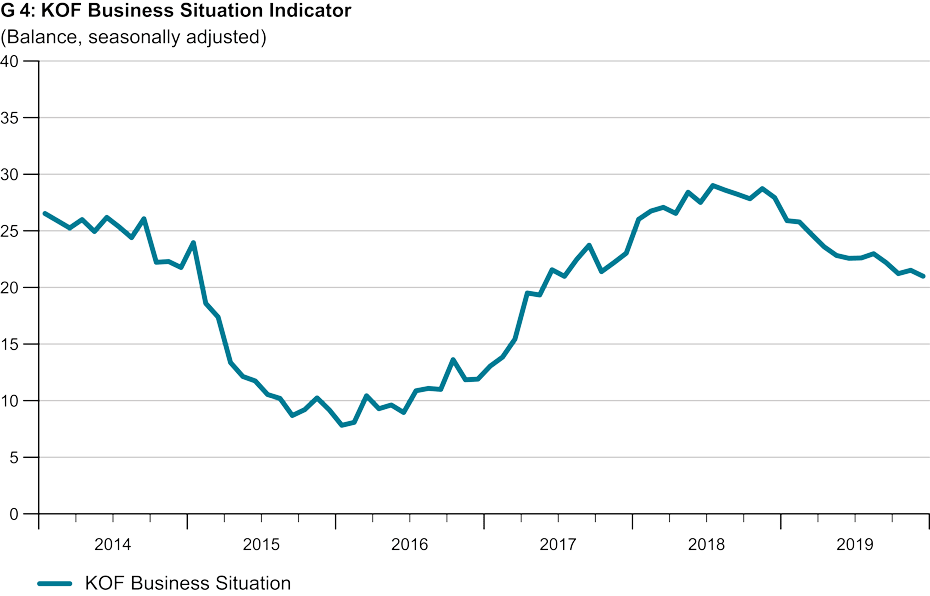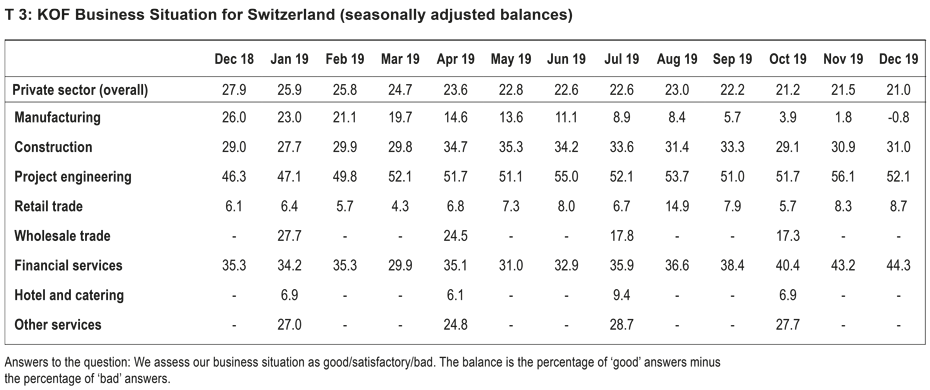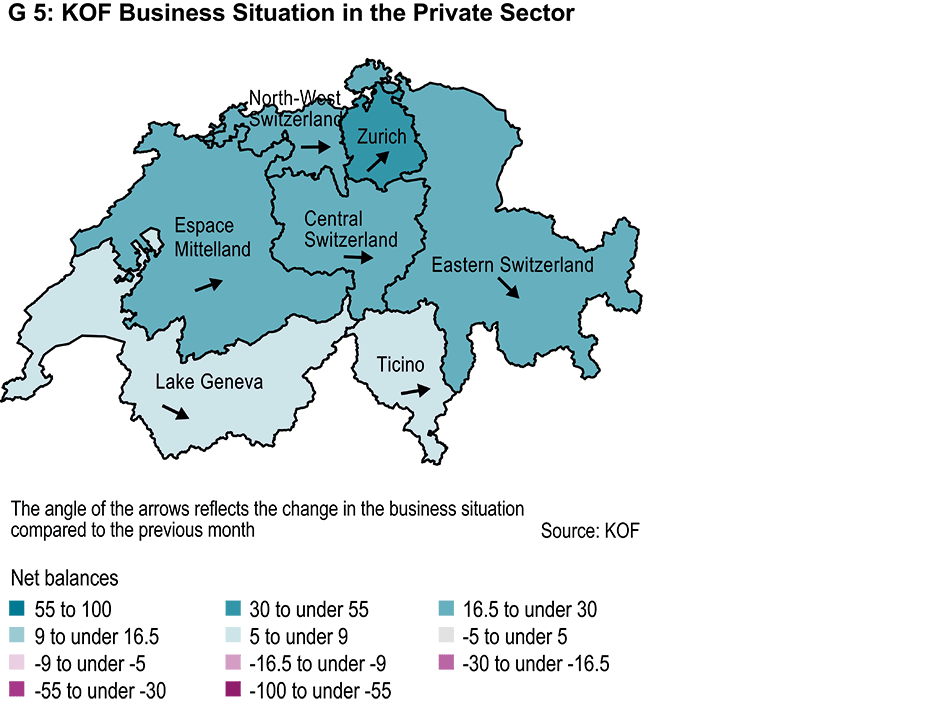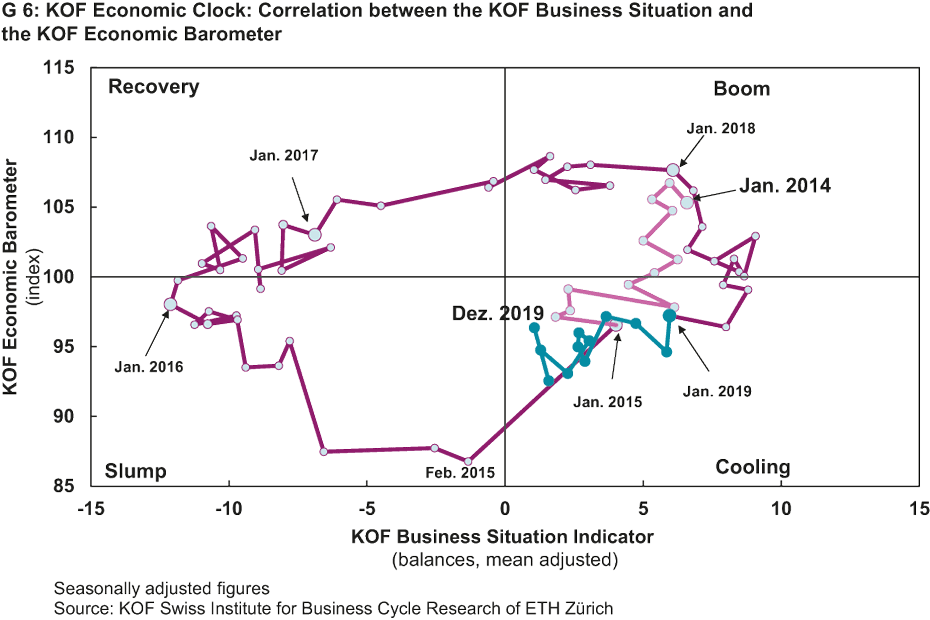KOF Business Situation Indicator: Swiss Companies Report Downturn at the End of the Year
- KOF Business Situation Indicator
- KOF Bulletin
Towards the end of 2019, the business situation of Swiss companies slowed down again (cf. G 4). The Swiss economy is held back by the sluggish trend in the manufacturing industry. By contrast, the construction industry and numerous service sectors reported a stabilisation of the business trend. Overall, the difficult international environment continues to place a strain on the Swiss economy.
The breakdown into different sectors shows that the Business Situation Indicator in the manufacturing industry declined further towards the end of 2019, which overall was a slow year for this sector (see T 3). In the great majority of the manufacturing industry segments, the business situation at the end of 2019 was less favourable than at the end of 2018. Especially segments that reported an excellent situation in December of 2018, such as chemicals and plastics or machinery and vehicles, slowed down significantly over the past twelve months. However, in the construction and retail industries, the business situation in December 2019 had changed very little, both in comparison to the previous month and compared to December 2018. The financial and insurance service providers and the project engineering sector reported a positive trend, although the latter did not quite maintain its auspicious situation of last November.
Wholesalers, the hotel and catering companies and the other service providers were last surveyed in October. At the time, the situation was slowing down in all three sectors.
In regional terms, the Business Situation Indicator followed different trends in December (see G 5). While the situation improved in the Zurich region and in Espace Mittelland, it was less favourable than a month before in Eastern Switzerland and the Lake Geneva region. There was little change in North West Switzerland, Ticino and Central Switzerland.
Over the year as a whole, Eastern Switzerland recorded the biggest loss, with the business situation currently less positive than at the end of 2018. By contrast, the Zurich and Lake Geneva regions generally managed to maintain their business situation, while Ticino even reported an improvement.
Explanation
Graph G 4 presents the KOF business situation across all sectors covered by the survey. The business situation in sectors which are surveyed on a quarterly basis is kept constant during the intervening months.
Graph G 5 presents the business situation in the main regions pursuant to the Federal Statistical Office. The regions are coloured according to business situation. The arrows in the regions indicate the change in the business situation compared to the previous month. An upward-pointing arrow, for instance, indicates that the situation has improved over the previous month.
The KOF Economic Clock (Graph G 6) plots the Business Situation Indicator against the KOF Economic Barometer. The Business Situation indicator represents the current economic situation, whilst the Barometer provides an early indicator of any changes in activity. The clock can be divided into four quadrants. During the recovery phase the business situation is below average, whilst growth prospects are above average. During the boom phase both the business situation and prospects are above average. During the cooling phase the business situation is below average whilst prospects are declining. During the slump phase both the business situation and prospects are below average. Theoretically, the graph should move through the quadrants in a clockwise direction over time.
The KOF business situation is based on more than 4,500 reports from businesses in Switzerland. Each month, companies are surveyed in the economic sectors of industry, retail trade, construction, project engineering and financial and insurance services. Businesses in the hotel and catering sector, wholesalers and other service providers are surveyed on a quarterly basis in the first month of each quarter. Among other questions, the companies are asked to assess their current business situation. They may class their situation as “good”, “satisfactory” or “bad”. The balance of the current business situation is the percentage difference between the answers “good” and “bad”.
Contact
KOF Konjunkturforschungsstelle
Leonhardstrasse 21
8092
Zürich
Switzerland



